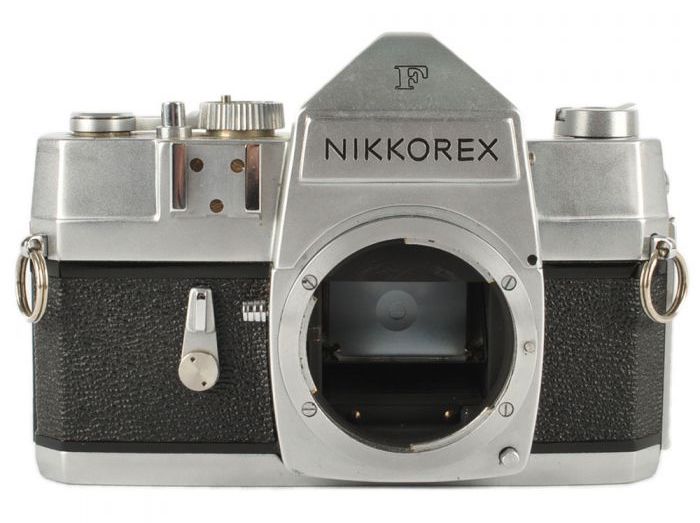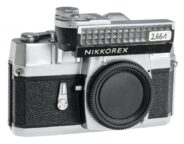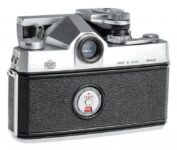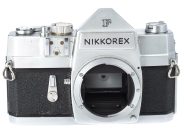Nikkorex F
akaNikkor J
35mm MF film SLR camera • Discontinued
Specification
| Format: | |
| 35mm full frame | |
Film type: | 135 cartridge-loaded film |
| Nikon F [46.5mm] | |
| Shutter: | |
Type: | Focal-plane |
Model: | Mechanical |
Speeds: | 1 - 1/1000 + B |
| Exposure: | |
Exposure metering: | None |
Exposure modes: | Manual |
| Physical characteristics: | |
Weight: | <No data> |
Dimensions: | <No data> |
Manufacturer description
The Nikkorex F gives the franchised Nikon Dealer a powerful competitive advantage in selling medium-priced 35mm reflex cameras.
He offers his prospects 20 Nikkor and Auto-Nikkor lenses to fit the Nikkorex F - the finest and widest range of interchangeable lenses avaliable for any camera in this price range.
He can offer so wide a group of accessories that the Nikkorex F becomes the most versatile camera in its class.
And he sells a camera with every modern, advanced feature, automatic instant-return mirror, automatic instant-reopen diaphragm, depth of field preview button, all metal focal plane shutter, with speeds to 1/1000, and electronic flash synch to 1/125.
Equally important, the Nikon Dealer can get his share of these profitable lens and accessory sales with a basic investment in the Nikkorex F camera. With one line of lenses and accessories the Nikon Dealer holds the key to two major markets big-ticket '35', with the Nikon F, medium priced '35' with the Nikkorex F.
NIKKOREX "F" AUTOMATIC REFLEX CAMERA - 35mm; 36 exposure, 1" x 1 1/2" Features. automatic instant return mirror and automatic instant reopen diaphragm; depth of field preview control. Fresnel-type focusing screen with split-prism rangefinder. Accepts 19 interchangeable Nikkor and Auto-Nikkor lenses. Accepts most Nikon F accessories. Accessory exposure meter couples to diaphragm and shutter; metal focal plahe shutter; 13 shutter speeds, click-stop, from 1 to 1/1000 plus T & B, on single non-rotating dial; 'M' (flashbulb) synch at all speeds; 'X' (electronic flash) synch to 1/125. Variable self-timer, delays action up to 10 seconds. Auto zero reset exposure counter; hinged back; fixed take-up spool; single stroke rapid film advance; high speed film rewind.
AUTOMATIC RETURN MIRROR
Returns instantly, automatically to focusing-viewing position after exposure; no finder 'black-out'. Camera is always ready for focusing and viewing.
AUTOMATIC REOPEN DIAPHRAGM
Closes to aperture selected for exposure then instantly, automatically re-opens to maximum aperture; finder screen never dims.
DEPTH OF FIELD PREVIEW BUTTON
Permits viewing of depth of field at 'taking' aperture or selecting 'taking' aperture on basis of desired depth of field.
Lens is always wide open to provide most brilliant image for focusing and viewing; pressing preview button automatically closes diaphragm to pre-selected aperture. Release button and lens automatically re-opens.
INTERCHANGEABLE NIKKOR LENSES
Accepts 20 interchangeable Nikkor and Auto-Nikkor lenses. Same superb optics used on the famous Nikon F. Finest and widest selection available for medium priced camera. Lenses range from 28mm wide angle to 1000mm super telephoto. Includes micro lens, zooms and catadioptric systems.
INTERCHANGEABLE NIKON F ACCESSORIES
Accepts most Nikon F accessories. Widest and finest selection available for a medium priced camera. Interchangeable accessories include: copy outfits; bellows attachment; extension tubes; micro equipment; telescope adapter; filters; lens caps and hoods. Lens-and-diaphragm coupled exposure meter, similar to Nikon F meter but designed to fit Nikkorex F, is also available.
From the Nikon Journal (Vol. 16 No. 3, June 30, 1999)
Ask most people to name the alternative to the top of the line "F" models & they usually tick off the Nikkormat series followed by the FE/FM cameras. But wasn't there anything before July 1965 when the Nikkormat FT was released? Of course there was, but even Nikon will seldom mention what it was. Much of their historical material doesn't even list it! But in July 1962 the "fIrst" alternative to the "F" was released and it was the Nikkorex F. It may not be on most peoples' want list, but the Nikkorex F was Nikon's fIrst attempt at a lower priced alternative to the "F".
But why make a "lesser" camera at all? Simple business sense, thats' why. The idea was to expand the market for the lenses! If you could open the market for the world class Nikkors to people other than pros and advanced amateurs, the main targets for the Nikon F, the possibilities were endless. Thus the idea of a lower priced Nikon was a sound business decision and one that makes a great deal of sense. But with the Nikkorex F there is also an interesting story most people are not aware of.
The Nikkorex F was actually designed, developed and produced by another manufacturer! Who you may ask? None other than Mamiya! The story goes that the design of the Nikkorex F was in its final stages when Nippon Kogaku and Mamiya got together to talk. It is not known at this time who approached whom, but all that was needed to fInish the camera was to modify the mount and the automatic diaphragm mechanism to work with Nikkors, and the Nikkorex F was ready! But why Mamiya? It appears that both companies had a somewhat close relationship over the years. One of the few times that NK ever made their lenses available to another maker was for the Marshal Press, the brain child of the founder of Mamiya. And take a look at the Mamiya M645 system. Ever notice the little meter coupling prong on its lenses? Right out of Nikon's design book! And it was patented, so Mamiya could not use it without Nikon's blessings. And now we see that the only time NK ever allowed someone to use their bayonet mount it turns out to be Mamiya yet again.
The Nikkorex F was the "first" camera on the market to use the "Copal Square all metal blade vertically traveling focal plane shutter". The shutter was being developed by the Copal Co. around 1960 with the help of 3 camera manufacturers who were to receive exclusive use of the shutter when it was ready. Nikon was not one of the 3, but Mamiya was! Another point to consider is that Joe Ehrenreich would have been involved, as usual, with the Nikkorex project, and guess who was one of the marketers of Mamiya products?!
In the end the Nikkorex F was not a successful camera, and its replacement, the Nikkormat FT, readily met the needs of the public who now felt there was room for a lesser Nikon, even though the Nikkorex F was not it! The Nikkormat body was made by Nikon, but it still used the Copal shutter, so the Nikkorex F project bore fruit in the end.
The only really interesting variations of the Nikkorex F are the German market "Nikkor J", and the black Nikkorex F made for the Swedish government, shown here. It is suggested that only 125-150 black Nikkorexes were made, and they are seldom seen on the market.
So don't look down on the Nikkorex F too much! Just remember that it is the only Nikon that isn't a Nikon! That it is the only camera made to take Nikkor lenses (other than Russian & Chinese rip-offs) not made by Nikon! A not so great camera, but unique in all the history of Nikon!
From the Nikon Journal (Vol. 12 No. 2, March 31st, 1995)
After the introduction of the Nikon F, Nippon Kogaku wished to place an inexpensive interchangeable SLR camera into the hands of the everyday consumer. This camera would open the door, in a very economical way, to the universal Nikon system of lenses. This move would also insure future purchases of its top of the line cameras when the consumer finally "graduated" to a Nikon F.
Nippon Kogaku once again went to the Mamiya company to produce this new camera, just as they had done for their Nikkorex-35 in 1960. It must be noted, that the collaboration between companies during the early developmental years of the Japanese SLR industry was not uncommon. The reason why Nippon Kogaku went to Mamiya was because it was a stop-gap attempt by management to produce this model while its own facilities were trying to meet the ever increasing orders for the Nikon F! It must also be noted that Nikon was working diligently to create the tools and dies needed to produce the Nikkormat series of cameras.
The Nikkorex F was introduced to the public in 1962. It was a manual camera with instant return mirror, a shutter speed range of 1 to 1/1000th sec plus B, MX synch, and X at 125th sec. This was the first Nikon to have a vertical traveling focal plane shutter with metal leaves. The shutter was supplied to Nikon by Copal. It came with a 50mm/f2.0 Auto Nikkor lens and it could utilize all other Nikkors and would take a special line of Sekor-Nikkorex lenses (the 35/2.8 lens being the one lost commonly found).
The finder was a fixed pentaprisl with central microprism and matte collar in a fresnel screen. It had such "expensive" features as a depth of field preview, a self-timer and an auto resetting frame counter. It did not come with an integrated exposure meter. A clip-on selenium meter could be mounted and coupled with the shutter speed dial and the meter pin on the lens, via an accessory on the front of the camera. This type of metering was similar to the external selenium meter made for the Nikon F.
Production of the Nikkorex F ran from 1962 to 1966. The features on this model were comparable to the Nikkormat FS which was introduced later in 1965 along with the new Nikkormat FT.
All of the Nikkorex models made by Mamiya, including the "F", were not known for their workmanship or quality. None of these cameras had that everlasting feel to them that a Nikon F or Nikkormat possess. Breakdowns, on all models, were frequent. It is with some effort today to find a used Nikkorex F that has all parts and meter working.
Nikon has disavowed the whole line of Nikkorex models from its family tree of cameras. I assume they feel that these cameras were not true Nikons but hybrids of a sort and were far from being professionally oriented and durable cameras that Nippon Kogaku is noted for. However, the story of the Nikkorex F does not end here! The Nikkorex F was patterned after the Mamiya SLR which was the grandaddy of many cameras during the 1960s.
The first Nikkorex F was the Tower 37, a 1961 SLR made by Mamiya for Sears. It came with a preset Mamiya/Sekor lens and did not have an instant return mirror. In 1963 the Mamiya SLR was introduced. This unique camera had a Mamiya body with a Canon f1.9 lens in an Exakta mount! This camera was originally sold by Olden Camera in New York. Again in 1963, the Nikkorex F now became the Argus SLR with an Argus/Sekor 58mm/f1.7 lens. Finally, in 1964, this camera resurfaced AGAIN as the Ricoh Singlex and stayed in production till 1966. Ricoh bought the tools and dies from Mamiya to produce the Singlex and redesigned the camera slightly. The Ricoh Singlex had a Nikon lens mount and could take the Nikkor and Sekor/Mamiya lenses that were already available. The Singlex had a 55mm/f1.4 Rikenon semi-automatic lens in Nikon bayonet mount. Ricoh also introduced a 35mm, 400mm and a 90-190mm/f5.8 Zoom for the camera. This camera was identical to the Nikkorex F including the front mounted accessory shoe for a clip-on meter. This model also came out as the Sears SLII but with a Pentax thread mount!
For a camera with such a miserable track record for durability and workmanship, the Nikkorex F and all its cousins just kept on re-emerging everywhere! There may be other SLRs out there that were based on this design. However, the only camera described above that has held and increased its value is the Ricoh Singlex.
From the Nikon Journal (Vol. 9 No. 4, July 25, 1992)
When Nikon items were imported into Germany by the German company Varimex, Frankfurt, who started in 1963, Zeiss Ikon, Stuttgart, thought that the name "Nikon" looked and sounded very much like their name "Ikon". And they started a legal battle against the name "Nikon". However, this battle was not between Zeiss and Nikon Japan, but between Zeiss and Varimex. Zeiss won this battle and so every item with the name Nikon which was imported into Germany must have another name. Therefore, all Nikon items imported into Germany were renamed "NIKKOR", the same as their lenses. All items!!! Cameras, finders, Photomics, meters, motors, bellows, relay boxes, screens, flashes and everything else. Even the brochures and instruction books used only photos showing "NIKKOR" marked items!
The legal battle was not settled until Photokina 1968, where Nikon announced that all items would now be engraved "Nikon" worldwide.
But now to the "NIKKOR J". This camera is exactly the same as the Nikkorex F. Very little is known about the NIKKOR J and it was not a fast selling camera. But why the name "NIKKOR J" ? The original Nikkorex name did not sound at all like anything having to do with Zeiss, so why Nikkor? The answer is that 3 different names for their products in one country may have been confusing (Nikon F, Nikkor F, and Nikkorex F). So Nikon called all their items in Germany "Nikkor", thus the name "NIKKOR J". But again, why "J"? Because the Nikon F was called Nikkor F in Germany and they could not rename the Nikkorex F a Nikkor F! So the letter "J" was chosen.
From the editor
The Nikkorex series cameras was Nikon's attempt to produce a more affordable alternative to the professional Nikon F. These cameras were made in collaboration with Mamiya, and their design was not exclusive to Nikon.
The Nikkorex F was the first Nikon camera to have a focal plane shutter supplied by Copal, with metal blades that travel vertically. The camera did not have an integral exposure meter. If required, a selenium cell unit, which coupled with the shutter speed dial as well as the meter-coupling pin of the lens could be fitted.
Similar cameras (30)
| Model | Shutter | Metering | Modes | Year |
|---|---|---|---|---|
| Kiev-17 akaКиев-17 |
M, 1/1000 | -- | M | 1978 ● |
| Kiev-19 akaКиев-19 |
M, 1/500 | TTL · WA | M | 1985 ● |
| Kiev-19M akaКиев-19М |
M, 1/500 | TTL · OA | M | 1988 ● |
| Kiev-20 akaКиев-20 |
M, 1/1000 | TTL · OA | M | 1983 ● |
| Nikkormat EL | E, 1/1000 | TTL · OA | AM | 1972 ● |
| Nikkormat ELW | E, 1/1000 | TTL · OA | AM | 1976 ● |
| Nikkormat FS | M, 1/1000 | -- | M | 1965 ● |
| Nikkormat FT | M, 1/1000 | TTL · OA | M | 1965 ● |
| Nikkormat FT2 | M, 1/1000 | TTL · OA | M | 1975 ● |
| Nikkormat FT3 | M, 1/1000 | TTL · OA | M | 1977 ● |
| Nikkormat FTN | M, 1/1000 | TTL · OA | M | 1967 ● |
| Nikon EL2 | E, 1/1000 | TTL · OA | AM | 1977 ● |
| Nikon EM | E, 1/1000 | TTL · OA | A | 1979 ● |
| Nikon F | M, 1/1000 | -- | M | 1959 ● |
| Nikon F2 | M, 1/2000 | -- | M | 1971 ● |
| Nikon F3 | E, 1/2000 | TTL · OA | AM | 1980 ● |
| Nikon FA | E, 1/4000 | TTL · OA | PASM | 1983 ● |
| Nikon FE | E, 1/1000 | TTL · OA | AM | 1978 ● |
| Nikon FE10 | E, 1/2000 | TTL · OA | AM | 1996 ● |
| Nikon FE2 | E, 1/4000 | TTL · OA | AM | 1983 ● |
| Nikon FG | E, 1/1000 | TTL · OA | PAM | 1982 ● |
| Nikon FG-20 | E, 1/1000 | TTL · OA | AM | 1984 ● |
| Nikon FM | M, 1/1000 | TTL · OA | M | 1977 ● |
| Nikon FM10 | M, 1/2000 | TTL · OA | M | 1995 ● |
| Nikon FM2 | M, 1/4000 | TTL · OA | M | 1982 ● |
| Nikon FM2/T | M, 1/4000 | TTL · OA | M | 1993 ● |
| Nikon FM3A | E, 1/4000 | TTL · OA | M | 2001 ● |
| Nikon N2000 akaNikon F-301 |
E, 1/2000 | TTL · OA | PAM | 1985 ● |
| Nikon N6000 akaNikon F-601M |
E, 1/2000 | TTL · OA | PASM | 1990 ● |
| Ricoh Singlex | M, 1/1000 | -- | M | 1962 ● |







